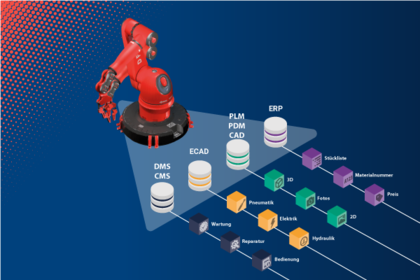4 Benefits of Integrating Field Service Management Software and a Digital Spare Parts Catalog
Service technicians in the field face a wide range of challenges. Their primary goal is to resolve failures quickly and to carry out repairs and maintenance procedures at the customer's site efficiently and to their satisfaction.
This can be achieved by using a suitable software solution. The service technicians can quickly and easily access:
- all relevant customer information
- the service order
- the machine to be repaired
- all necessary spare parts
And they can do this on the move, from anywhere and at any time. But how can this be achieved and what should such a solution look like?
Software supports efficient service
Service technicians usually use Field Service Management (FSM) software to plan, execute and document service orders. All relevant information on spare parts as well as technical documentation, circuit diagrams, pneumatic diagrams and hydraulic diagrams are stored in service information systems (SIS) and intelligently linked with each other.
To enable service technicians on the way and at the customer's site not only to manage service orders, but also to identify and order the right spare part directly, it is recommendable to integrate the two systems.
This allows the service technician to jump directly from the service report to the corresponding parts catalog by clicking a button during the service call: He identifies the required spare parts from the respective machine data record, sees further information such as images, 3D graphics, 2D drawings, parts list entries, the matching sections from the technical documentation, circuit diagrams and much more.
But why is this profitable and what added value do you gain from it?
BENEFIT 1: ALL INFORMATION AT A GLANCE
All relevant data is available to the service technician on a single platform. The technician can switch back and forth between service reports, spare parts catalogs and technical documentation at any time without media disruption or system changes. Thanks to networking of the information, he gets directly to the right place within the system to quickly and efficiently find all the information he needs to process the order. This significantly reduces research times and leads to faster processing of the service call.
BENEFIT 2: BETTER UTILIZATION OF EXISTING RESOURCES
Thanks to a reduction in research times, service technicians can concentrate on their core task - repairing a machine or maintaining a system. By reducing the time required per call, field technicians can be scheduled more efficiently. The resource of service technicians - which is more in demand than ever anyway due to demographic change - can thus be better utilized. Without increasing the number of service technicians, more calls can be made per day. This is an advantage that will benefit service managers in particular. In addition, existing service data is used more efficiently.
BENEFIT 3: INCREASED FIRST TIME FIX RATE
Quick identification and direct ordering of the required spare parts, coupled with links to the relevant locations within the technical documentation, enables the field service employee to fix the fault more quickly. This results in shorter downtime and saves the customer valuable costs by increasing productivity.
BENEFIT 4: HIGHER CUSTOMER SATISFACTION
Service is the new sales. Excellent service strengthens customer loyalty and helps win more business as well as boosting spare parts and service business.


